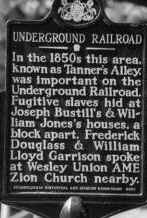
Study Areas:
Anti-Slavery
July 1821: Benjamin Journey, tavern servant, escapes from Georgetown
One
Hundred
Dollars
Reward.
Ran away from the subscriber, from the Union Tavern, Georgetown, District
of Columbia, on the 8th July, a negro man, by the name Benjamin Journey.
He is about 25 years of age, five feet three inches high, remarkable stout,
straight and well made; tolerable large legs, and generally has a smile
on his countenance when spoken to; his eyeballs are very large and appear
to roll about very much, the whites of the same are very conspicuous; his
features are rather boyish, particularly his mouth, which is small for
a negro; his lips are remarkably red. He has a stiff walk, and bows out
his arms very much, with a consequential air.
He was purchased from Mr. John Gadsby, late proprietor of the Indian Queen, Baltimore, where he was a waiter for many years. Mr. Gadsby bought him of Mr. Howard Duvall, of Prince George county, Maryland.
It is believed he is either loitering about Baltimore, or gone off toward Pennsylvania, in company with a large mulatto wench.
I will give twenty dollars, if taken in the District of Columbia; fifty dollars, if in the state of Maryland, & the above reward if taken out of the state of Maryland, so as he is secured in any jail, that I may get possession of him.
Thomas
Crawford.
Georgetown, D. C., July 20.
Source: Lancaster Journal, 3 August 1821.
Editors' Notes: The Union Tavern stood at 2921 M Street Northwest. It burned down in 1832. Baltimore's Indian Queen Tavern stood at the southeast corner of Baltimore and Hanover streets. It is reportedly at the Indian Queen that Francis Scott Key finished his poem "Defence of Fort McHenry" on September 16, 1814, after witnessing the bombardment of that fort by British warships a few days earlier. This poem was set to music a month later, and became "The Star-Spangled Banner," and was first publicly performed that October in McCauley's Tavern by Ferdinand Durang, who was in Baltimore with a company of American defenders from Harrisburg.
John Gadsby was the largest slave owner in Baltimore in 1813, using his thirty-six slaves to run the Indian Queen hotel. (Seth Rockman, Scraping By: Wage Labor, Slavery and Survival in Early Baltimore, 2009, p. 112.)
 Covering
the history of African Americans in central Pennsylvania from the colonial
era through the Civil
War.
Covering
the history of African Americans in central Pennsylvania from the colonial
era through the Civil
War.
Support the Afrolumens Project. Buy the books:
The Year of Jubilee, Volume One: Men of God, Volume Two: Men of Muscle

